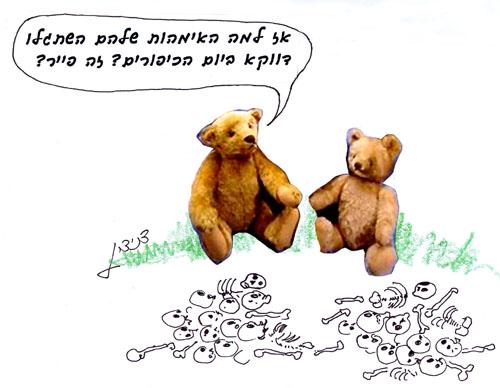
After Elijah the prophet went up to heaven in a storm, he was replaced by Elisha the prophet. It is written of Elisha “Then he went up from there to Bethel; and as he was going up the road, some [ne’arim ketanim] child-youths came from the city and mocked him, and said to him, ‘Go up, you baldhead! Go up, you baldhead!’ So he turned around and looked at them, and pronounced a curse on them in the name of the Lord. And two female bears came out of the woods and mauled forty-two of the youths” (II Kings 2:23-24). The sages try to clarify the meaning of the self-contradictory phrase child-youths; if they were children they were not youths, and vice versa. One sage, R’ Elazar, explicated [by taking the written word as something beyond its plain meaning): ne’arim, for they had shaken off [m’nuarim] the commandments, ketanim, for they were small of faith, and only worried about their livelihood being reduced. (Elisha, using magic powers, changed non-potable water into potable, causing these youths to lose the money they would have made by selling drinking water.) A different sage said: They were youths, but acted frivolously, like children. One of the scholars, Rav Yossef, asked: Why do we not interpret the word ne’arim as showing that they were from a place called Ne’uran? [There is a place named Ne’uran mentioned in the Bible: “East of Na’aran” (I Chronicles 7:28]. To support his question, he brought proof of his interpretation from a different place in Kings, which states ” And the Syrians had gone out on raids, and had brought back captive a [na’arah ketanah] female child-youth from the land of Israel. She waited on Naaman’s wife” (II Kings 5:2). This verse includes a contradiction similar to the one under discussion; if she is a child, she is not a youth, and vice versa. One of the sages, Rav Padat, reconciled the contradiction by saying that she was a child who had lived in Ne’uran, and this explanation was accepted by all the sages. If so, argued Rav Yossef, let us also interpret the words before us, ne’arim ketanim as children who lived in Ne’uran. Answer: The verse in the story of Elisha tells us that the youths lived in Jericho, so we cannot interpret the verse as saying they lived in Ne’uran. The sages continued to explicate the verse: “So [Elisha] turned around and looked at [the youths], and pronounced a curse on them in the name of the Lord.” The sages asked: What did Elisha see that made him decide to kill them? Answer: One sage, Rav, argued that Elisha “saw,” that is, that he looked at them meaning to kill them in the manner common amongst the sages and holy men, in whose power it is to kill with a glance. (In the words of the sages, “Everywhere the sages looked they brought either death or poverty.”) A different sage, Samuel, explained: Elisha “saw” that the children/youths who had mocked him were the products of sexual relations on the Day of Atonement (a forbidden act), and so killed them. A different sage, Rabbi Isaac Nafcha, said that Elisha saw that these youths had grown forelocks, as was the custom of the gentiles, and that is why he killed them. Yet another sage, R’ Yochanan, explained that Elisha “saw” they had not a speck of commandment observance. The scholars asked: Though the youths were sinners, Elisha should not have killed them, for perhaps their descendants would have been righteous people. Answered the sage R’ Elazar: Elisha saw through prophecy that none of their descendants would be righteous, and so he killed them. The sages continued to discuss the verse. “And two female bears came out of the woods and mauled forty-two of the youths [to death].” One sage, Rav, thought that only one miracle occurred for Elisha, that the bears appeared miraculously, but that the forest had already existed. Another sage, Samuel, thought that two miracles happened (in the words of the sages, a miracle within a miracle), both the bears’ appearance and a field turning into a forest. The scholars asked: Why did a miracle have to happen and turn the field into a forest? It would be enough were bears to appear and kill the youths. Answer: If the field had not turned into a forest the bears would have been frightened of attacking the youths in an open field, but in a forest the bears feel confident enough to attack.
(Babylonian Talmud, Tractate Sotah 46b-47a)
